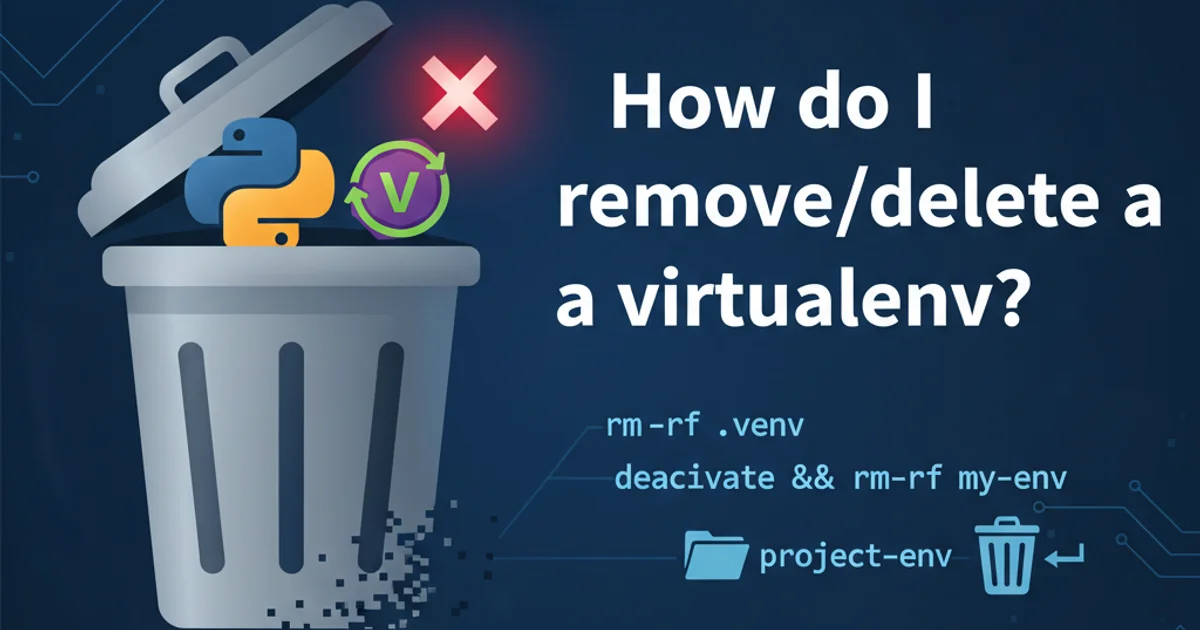How do I remove/delete a virtualenv?
Categories:
How to Remove or Delete a Python virtualenv

Learn the correct and safe methods to remove a Python virtual environment, ensuring a clean development setup.
Virtual environments are crucial for Python development, allowing you to manage project-specific dependencies without conflicts. However, there comes a time when a virtual environment is no longer needed – perhaps the project is complete, or you're cleaning up your development machine. This article will guide you through the straightforward process of safely deleting a virtual environment, whether it was created with venv or virtualenv.
Understanding Virtual Environments
Before diving into deletion, it's helpful to understand what a virtual environment is. Essentially, it's a self-contained directory that holds a Python interpreter and all the packages installed for a specific project. This isolation prevents package version clashes between different projects. When you 'activate' a virtual environment, your shell's PATH is temporarily modified to point to the environment's Python and scripts.
flowchart TD
A[Start Project] --> B{Create Virtual Environment}
B --> C[Install Dependencies]
C --> D[Develop Project]
D --> E{Project Complete / No Longer Needed}
E --> F[Deactivate Virtual Environment]
F --> G[Delete Virtual Environment Directory]
G --> H[Clean Up Complete]Typical lifecycle of a virtual environment
The Simple Deletion Method: Removing the Directory
The most common and effective way to remove a virtual environment is to simply delete its directory. A virtual environment is just a folder containing files, and once you remove that folder, the environment is gone. There's no special 'uninstall' command for venv or virtualenv itself.
1. Step 1: Deactivate the Virtual Environment
If your virtual environment is currently active, you'll see its name (e.g., (myenv)) at the beginning of your shell prompt. You must deactivate it first.
2. Step 2: Navigate to the Parent Directory
Change your current directory to the parent directory where your virtual environment folder is located. For example, if your project is in ~/projects/my_project and your virtual environment is ~/projects/my_project/venv, navigate to ~/projects/my_project.
3. Step 3: Delete the Virtual Environment Directory
Use your operating system's command to remove the directory. This command will permanently delete all files and subdirectories within the virtual environment folder.
# Deactivate the virtual environment (if active)
deactivate
# Navigate to the parent directory of the virtual environment
cd ~/projects/my_project
# Delete the virtual environment directory
rm -rf venv
# For Windows (Command Prompt)
# rmdir /s /q venv
# For Windows (PowerShell)
# Remove-Item -Recurse -Force venv
Commands to deactivate and delete a virtual environment directory.
venv, .venv, or env.Using virtualenvwrapper for Management
If you use virtualenvwrapper (a set of extensions for virtualenv), managing virtual environments, including deletion, becomes even simpler. virtualenvwrapper stores all environments in a central location (usually ~/.virtualenvs), allowing you to manage them from any directory.
# Deactivate the virtual environment (if active)
deactivate
# Remove the virtual environment using virtualenvwrapper
rmvirtualenv myenv
Deleting a virtual environment using virtualenvwrapper.
rmvirtualenv command handles both deactivation and deletion of the environment from its central location, making it a very convenient tool for virtualenvwrapper users.By following these methods, you can efficiently and safely remove unwanted Python virtual environments, keeping your development environment clean and organized.